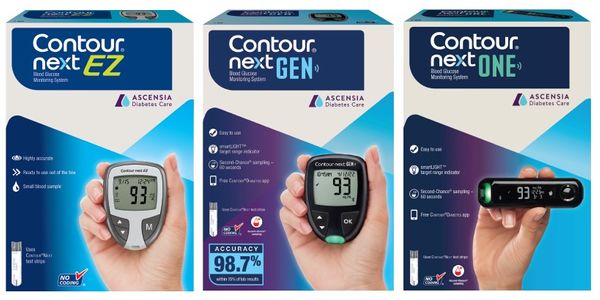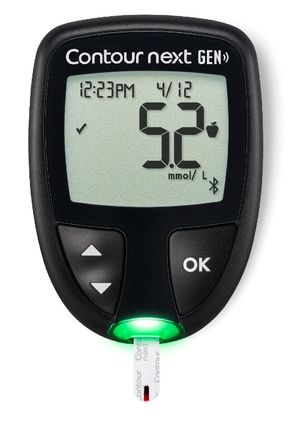Diabetes Education and Support

Did you know?
Diabetes is a growing global health concern. The Centers for Disease Control and Prevention reports that over 30 million people are affected by diabetes in the United States.₁ Diabetes can affect many parts of the body, and if left uncontrolled, it may lead to complications. However, people with diabetes, together with their healthcare team, family, and support network, can reduce the risk of complications by maintaining their blood sugar within a healthy range. Blood pressure and lipids (such as cholesterol and triglycerides) may also be monitored frequently by your healthcare provider (HCP).₂
- References 1. Center for Disease Control and Prevention. National Diabetes Fact Sheet, 2017. Atlanta, GA: Center for Disease Control and Prevention, US Dept Health and Human Services; 2017 2. American Diabetes Association (ADA). Standards of Medical Care in Diabetes. Diabetes Care 2019;42(Suppl 1):S1-S193

You are in charge
Living with diabetes may seem complicated, but understanding it can help you take control. Pay attention to:
- Eating healthy food in healthy amounts
- Staying active
- Managing your stress effectively
- Taking your medications (if needed) as prescribed by your health care provider (HCP)
- Your blood sugar readings
- Visiting your HCP and healthcare team members per your regimen
- Getting all necessary laboratory tests done
Think about what you may want to talk with your healthcare team about:
- What is your blood sugar at different times of the day?
- How is your blood sugar control over time?
- What tests do you need to find out if you are developing any complications?

Blood sugar testing
What is Blood Sugar Testing?
A blood sugar (or blood glucose) test tells you how much sugar is in your blood at the moment it is tested. One way to find out the amount of sugar in your blood is to get a blood test in a doctor’s office. Another way to find out is to test it yourself. This is called self-monitoring or self-testing. Many factors affect your blood sugar levels every day. Testing your blood sugar may indicate if your meal plan, medication, and physical activity levels are working to help you manage your diabetes.
Who Should Test Their Own Blood Sugar?
Blood sugar testing is important for everyone with diabetes. People living with diabetes can learn how to test their own blood sugar using a blood glucose monitoring system.
How Can Blood Sugar Self-Testing Help You?
When you self-test regularly, you may learn what makes your blood sugar too high or too low. With the help of your healthcare team, you can make adjustments to your meal plan, medications, and physical activity levels that will help you better control your diabetes. When you keep your blood sugar in a normal range, you lower your risk of developing problems with your heart, eyes, kidneys, brain, feet, and nerves that can occur because of diabetes.₃
Reference: 3. Mayo Clinic.Hyperglycemia in Diabetes.https://www.mayoclinic.org/diseases-conditions/ hyperglycemia/symptoms-causes/syc-20373631. Accessed January 2019

Benefits of Using a CONTOUR®NEXT Blood Glucose Monitoring System and CONTOUR®NEXT test strips
PROVEN ACCURACY₄,₅: Help manage your diabetes and identify out of range blood glucose levels with personalized HI/LO target range and summary of your blood glucose test results.
FAST TEST TIME: Ready to test right out of the box to make daily testing easy with 5-second countdown
SECOND-CHANCE® SAMPLING: Allows you to apply more blood to the test strip being used, which may help prevent wasting test strips and save money.₆

HIGHLY ACCURATE₄,₅ TESTING: High-performance test strips calibrated for use with the CONTOUR®NEXT portfolio of blood glucose meters.
NO CODING ® TECHNOLOGY: Fast, highly accurate₄,₅ results in seconds with one less step in testing and eliminates errors due to user miscoding.
References: 4. Christiansen, M. et al. A New, Wireless-enabled Blood Glucose Monitoring System That Links to a Smart Mobile Device: Accuracy and
User Performance Evaluation. Journal of Diabetes Science and Technology. 2017, Vol. 11(3) 567-573. 5: Bernstein, et al. A New Test Strip Technology Platform for Self-Monitoring of Blood Glucose. J Diabetes Sci Technol 2013; 7(5): 1386-1399. 6. Ascensia Diabetes Care. Data on File. Second Chance Sampling Research Topline Report (May 2015) A 15-minute online study was conducted among people with diabetes. Hall & Partners.

What do your test strips really cost you? Maybe Too Much.
Buy CONTOUR®NEXT test strips over-the-counter and you may get a better price** compared to your insurance co-pay.
- Highly accurate₄,₅ test strips you can trust.
- Click here to view the Guide for Affordable Access to CONTOUR®NEXT Test Strips
- When it comes to diabetes management, trust CONTOUR®
**Patients should check with their insurance company as insurers may offer a lower cost option.
- 4. Christiansen, M. et al. A New, Wireless-enabled Blood Glucose Monitoring System That Links to a Smart Mobile Device: Accuracy and User Performance Evaluation. Journal of Diabetes Science and Technology. 2017, Vol. 11(3) 567-573. 5: Bernstein, et al. A New Test Strip Technology Platform for Self-Monitoring of Blood Glucose. J Diabetes Sci Technol 2013; 7(5): 1386-1399

Improving blood sugar self-testing
What Can You Do to Improve Your Self-Testing?
Talk to your healthcare team about your meter and how to test. Always follow the directions that come with your meter. An important thing you can do to ensure a good self-test is to properly wash and dry your hands right before the test, as explained in the user manual. If your hands are not completely clean, this can cause an incorrect blood sugar reading. Before doing the test, wash your hands in warm, soapy water and dry them well. DO NOT use alcohol-based hand sanitizers, gels or wipes in replacement of soap and water.
More Tips to Improve Your Self-Testing Practices:
- Keep your meter clean
- Keep your testing supplies at room temperature
- Check the expiration date of your testing supplies. Make sure your meter is correctly coded to the test strips you are using. CONTOUR®NEXT portfolio meters offer No Coding® technology to reduce the steps in the testing process and help you get easy, highly accurate results₄,₅
- Put your hand down to let gravity help the blood flow to your fingertips
- Stick the side of your finger with a new lancet in a lancing device
- Get enough of a blood drop to apply to the test strip. CONTOUR®NEXT portfolio meters offer Second-Chance® sampling, allowing you to apply more blood onto the same test strip which may help prevent wasted test strips₆
- Record the results in your logbook or smart device app
References: 4. Christiansen M et al. A New, Wireless Blood Glucose Monitoring System That Links to a Smart Mobile Device: Accuracy and User Performance Evaluation. J Diabetes Sci Technol 2017; 11(3):567-573. 5. Bernstein, et al. A New Test Strip Technology Platform for Self-Monitoring of Blood Glucose. J Diabetes Sci Technol 2013; 7(5): 1386-1399. 6. Ascensia Diabetes Care. Data on File. Second Chance Sampling Research Topline Report (May 2015) A 15-minute online study was conducted among people with diabetes. Hall & Partners.


CONTOUR®NEXT Blood Glucose Monitoring Products
CONTOUR®NEXT Blood Glucose Monitoring Products
Highly Accurate₄,₅ CONTOUR®NEXT Blood Glucose Meter Portfolio
The entire CONTOUR® NEXT portfolio of meters uses the same highly accurate₄,₅,₇ CONTOUR®NEXT test strips
References: 4. Christiansen, M. P. (2017). A New, Wireless-enabled Blood Glucose Monitoring System That Links to a Smart Mobile Device: Accuracy and User Performance Evaluation. Journal of Diabetes Science and Technology, 11(3), 567-573.. 5. Bernstein, R. et al. (2013). A New Test Strip Technology Platform for Self-Monitoring of Blood Glucose. Journal of Diabetes Science and Technology, 7(5), 1386-1399. 7. Bailey, J. et al. (2015). Accuracy and user performance evaluation of the Contour® Next Link 2.4 blood glucose monitoring system. Clinica Chimica Acta, 448(2015), 139-145


Managing your blood sugar
Healthy Nutrition
The American Diabetes Association (ADA) recommends nutrition therapy for all people with type 1 and type 2 diabetes. Consult with your healthcare team to find a Registered Dietician Nutritionist (RDN - an expert in nutrition) or other qualified HCP, who can personalize your meal plan to fit your individual needs. Within the first 6 months of your diabetes diagnosis, you should meet with your RDN 3 to 4 times. Don’t hesitate to ask for help with your meal plan. Many health insurance plans cover nutrition and diabetes education sessions.₈
Reference: 8. Vojta D, Koehler TB, Longjohn M, Lever JA, Caputo NF. A Coordinated National Model for Diabetes Prevention Linking Health Systems to an Evidence-Based Community Program. Am J Prev Med 2013;44(4S4):S301–S306.

Healthy Activity
Exercise is an important part of the diabetes management plan. Regular exercise has been shown to improve blood glucose control, reduce cardiovascular risk factors (blood pressure and cholesterol), contribute to weight loss, and improve well-being (reduce stress and increase energy levels).₉ Always talk with your healthcare provider before starting any exercise program.
Click here to access a Know Your™ Healthy Steps guide with tips for calculating your steps per day, making a plan to meet your goal steps, and getting in your steps – anytime, anywhere.
Reference: 9. American Diabetes Association (ADA). Standards of Medical Care in Diabetes. Diabetes Care 2019;42(Suppl 1):S1-S193.
